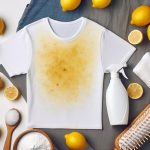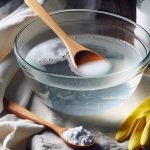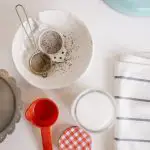I once thought those pesky black spots on clothes after washing were there to stay, but I discovered a few tricks that have proven to be lifesavers.
From checking fabric compatibility to using household staples like white vinegar and baking soda, there's a range of methods to tackle this common laundry dilemma.
But what about those stubborn stains that just won't budge? Stay tuned to find out how to deal with them effectively and restore your clothes to their former glory.
Table of Contents
Key Takeaways
- Use white vinegar solution to effectively remove black spots on clothes
- Consider hydrogen peroxide application for stubborn stains
- Try lemon juice and sunlight method for natural stain removal
- Apply baking soda paste to target and lift black spots from garments
Check for Fabric Compatibility
When checking for fabric compatibility, always consult the care label on the clothing item. Understanding fabric care is important to maintaining the quality of your clothes.
Laundry tips can vary depending on the type of fabric, so following the specific instructions provided is key. Different fabrics require different washing machine maintenance routines. Some may need gentle cycles or lower temperatures to prevent damage, while others can withstand more robust settings.
Additionally, selecting the right detergent is vital. Certain fabrics are sensitive to harsh chemicals, so choosing a mild detergent can help preserve the material and prevent black spots or other issues after washing.
Pre-Treat the Stains
To effectively address black spots on clothes after washing, I usually begin by pre-treating the stains. This step is important in ensuring the best chances of successful stain removal and fabric care strategies.
Here are some stain removal tips and fabric care strategies I find effective:
- Identify the Stain: Before pre-treating, identify the type of stain to use the most appropriate method.
- Use an Enzyme-Based Stain Remover: Enzyme-based stain removers are great for breaking down protein-based stains like blood or food.
- Try a Paste of Baking Soda and Water: This mixture works well on grease or oil-based stains.
- Apply White Vinegar for Mildew Stains: White vinegar is effective in removing mildew spots from clothes.
- Consider Lemon Juice for Rust Stains: Lemon juice can help lift rust stains from fabrics effectively.
Use White Vinegar Solution
I've found that white vinegar is a fantastic stain remover for those pesky black spots on clothes.
The application method is quite simple: just mix equal parts of white vinegar and water, then dab the solution onto the stained area.
Not only does vinegar effectively lift the stains, but it also helps freshen up the fabric.
Vinegar as Stain Remover
Tackling stubborn stains on clothes can be effectively done by utilizing a white vinegar solution. White vinegar offers a natural and cost-effective way to remove tough stains without harsh chemicals. Here are some key points to take into account when using vinegar as a stain remover:
- Gentle on Fabrics: White vinegar is gentle on most fabrics, making it suitable for various clothing materials.
- Natural Disinfectant: Apart from removing stains, white vinegar also acts as a natural disinfectant, ensuring your clothes are clean and fresh.
- Environmentally Friendly: Using white vinegar aligns with eco-friendly practices as it's non-toxic and biodegradable.
- Versatile Solution: White vinegar can tackle a wide range of stains, from food spills to sweat marks.
- Cost-Effective: Compared to commercial stain removers, white vinegar is a budget-friendly alternative.
Application Method Explained
When dealing with tough stains on clothes, utilizing a white vinegar solution can be a game-changer for effectively removing them.
To apply this method, mix one part white vinegar with two parts water in a spray bottle. Before spraying the solution on the stained area, make sure the garment is turned inside out.
Gently dab the affected area with a clean cloth soaked in the white vinegar solution. Let it sit for about 10-15 minutes to allow the vinegar to break down the stain. Afterward, wash the garment as usual following the fabric care tips.
This technique is a great addition to your stain removal techniques arsenal and promotes fabric care, ensuring your clothes stay in top condition.
Benefits of Using Vinegar
To make your laundry routine more effective and eco-friendly, consider utilizing a white vinegar solution for removing stubborn stains, such as black spots, from your clothes. White vinegar offers several benefits and properties that make it a great alternative to harsh chemicals. Here are some reasons why using a vinegar solution is effective:
- Natural and Eco-Friendly: Vinegar is a natural cleaning agent that's environmentally friendly.
- Gentle on Fabrics: It's gentle on fabrics, making it suitable for various clothing materials.
- Antibacterial Properties: Vinegar has antibacterial properties that can help eliminate odors.
- Color-Safe: White vinegar is safe to use on colored clothing without fading the colors.
- Cost-Effective: Vinegar is a cost-effective solution compared to commercial stain removers.
Apply Hydrogen Peroxide
I always make sure to spot-test hydrogen peroxide on a hidden part of the fabric to confirm it doesn't cause any damage.
Once I apply it to the black spots, I rinse the area thoroughly to remove any residue and prevent discoloration.
Spot-Test on Fabric
If you're unsure about how hydrogen peroxide will affect your fabric, try conducting a spot-test before applying it liberally. This simple step can save you from potential fabric damage.
Here are some key points to take into account:
- Fabric Compatibility Tests: Check if the fabric reacts adversely to hydrogen peroxide.
- Safety Precautions: Wear gloves to protect your skin during the spot-test.
- Alternative Stain Removal Methods: Explore eco-friendly options like vinegar or baking soda.
- Observe Color Changes: Note any discoloration or fading after applying hydrogen peroxide.
- Evaluate Texture Changes: Feel the fabric to make sure it hasn't become weakened or damaged.
Rinse Thoroughly After Applying
After spot-testing the fabric for compatibility with hydrogen peroxide, the next step is to thoroughly rinse the treated area to remove any residue.
Post wash care and fabric care are important aspects of stain removal techniques and garment care. Rinsing helps make sure that no hydrogen peroxide remains on the fabric, which could potentially cause damage if left untreated.
To rinse effectively, run the stained area under cold water, gently rubbing the fabric together to help release any leftover solution. Repeat this process until you no longer see any bubbles or feel any sliminess.
This thorough rinsing step is essential to maintain the integrity of your clothing and prevent any discoloration or damage from the hydrogen peroxide treatment.
Try Lemon Juice and Sunlight
Lemon juice and sunlight can be a powerful combination to tackle those pesky black spots on clothes after washing. I've found this method to be incredibly effective, and here are some tips to make the most of this natural alternative:
- Fresh Lemon Juice: Squeeze the juice from fresh lemons rather than using bottled lemon juice for better results.
- Direct Sunlight: Place the garment in direct sunlight after applying lemon juice to enhance the stain-removing process.
- Allow Time: Let the lemon juice sit on the stain for at least 30 minutes before sun exposure for best effectiveness.
- Check Fabric: Make sure the fabric is suitable for sun exposure to prevent any damage or color fading.
- Rinse Well: After sunning the garment, rinse it thoroughly to remove any lemon residue and prevent potential discoloration.
Use Baking Soda Paste
To tackle stubborn black spots on clothes after washing, creating a baking soda paste can be a game-changer. When faced with tough stains, turning to natural alternatives like this DIY stain removal method can often yield impressive results. Baking soda is a versatile ingredient known for its cleaning properties and is gentle on fabrics, making it a popular choice for treating stains.
To make a baking soda paste, start by mixing baking soda with a small amount of water in a bowl until you achieve a thick, spreadable consistency. Apply this paste directly onto the black spots on your clothes, ensuring they're fully covered. Gently rub the paste into the fabric using your fingers or a soft brush, allowing it to sit for about 30 minutes to penetrate the stains.
After letting the baking soda paste work its magic, wash your garment as usual. This method isn't only effective but also environmentally friendly and wallet-conscious, offering a simple yet powerful solution for dealing with pesky black spots on your clothes.
Apply Commercial Stain Removers
Curious about how commercial stain removers can tackle those stubborn black spots on your clothes? When dealing with tough stains, these products can be a game-changer. Here are some tips to make the most of commercial stain removers:
- Read the Instructions: Always follow the manufacturer's guidelines for the best results.
- Spot Testing: Before applying the stain remover to the entire garment, test it on a small, inconspicuous area to verify it won't damage the fabric.
- Pre-Treating: For particularly stubborn stains, consider pre-treating the affected area with the stain remover before washing.
- Choosing the Right Product: Different stains may require specific types of stain removers, so choose the product that aligns with the stain you're dealing with.
- Homemade solutions or Natural alternatives: If you prefer a more environmentally friendly approach, consider homemade solutions or natural alternatives like vinegar or lemon juice as stain removers.
Wash With Oxygen-Based Bleach
When dealing with stubborn black spots on clothes, using oxygen-based bleach in your wash can be a highly effective solution. Oxygen-based bleach, such as OxiClean or Clorox 2, is a powerful stain remover that can help lift tough stains without causing damage to your clothes. To use oxygen-based bleach, simply add the recommended amount to your washing machine along with your regular detergent before starting the wash cycle.
To prevent future black spots on your clothes, consider implementing stain prevention techniques such as pre-treating stains before washing, sorting clothes by color to avoid color bleeding, and using a gentle wash cycle for delicate fabrics. These practices can help keep your clothes looking fresh and stain-free.
If you prefer natural alternatives to oxygen bleach, you can try using lemon juice, white vinegar, or baking soda as eco-friendly stain removers. These natural ingredients can be just as effective in removing black spots and are gentle on both your clothes and the environment.
Final Rinse With Distilled Water
After utilizing oxygen-based bleach to address persistent black spots on clothes, contemplate giving them a final rinse with distilled water for a pristine finish. Personally, I find that this step enhances the overall cleanliness and appearance of my garments. Distilled water, with its purity and lack of minerals, can help prevent any residue or impurities from affecting the fabric.
Here are some benefits and techniques to contemplate for your final rinse:
- Preserves Fabric Quality: Distilled water is gentle on fabrics, aiding in maintaining their softness and color vibrancy.
- Minimizes Skin Irritation: By rinsing clothes with distilled water, you lessen the chances of skin irritation caused by detergent residues.
- Prevents Mineral Deposits: Distilled water lacks minerals that can leave deposits on clothes, ensuring they look clean and fresh.
- Enhances Brightness: The purity of distilled water can help clothes appear brighter and cleaner after washing.
- Eliminates Odors: A final rinse with distilled water can help remove any lingering detergent smells, leaving your clothes odor-free.
Frequently Asked Questions
Can I Use Bleach to Remove Black Spots on Clothes?
I prefer using bleach alternatives to remove black spots on clothes. They are gentler on fabrics and help preserve the color. Bleach can be harsh and may damage certain materials, so it's wise to contemplate safer options.
Is It Safe to Use Lemon Juice and Sunlight on All Types of Fabrics?
Using lemon juice and sunlight for stain removal depends on fabric compatibility. I've found it safe for whites, but cautious with colors. Always spot test and avoid prolonged exposure to prevent damage.
How Long Should I Let the White Vinegar Solution Sit on the Stain Before Washing?
Before washing, I let the white vinegar solution sit on the stain for about 15-30 minutes for effective pre-treating. For alternative methods, consider checking fabric compatibility. Soaking time impacts stain removal, so find what works best.
Are There Any Specific Commercial Stain Removers That Work Best for Black Spots?
I've tried various commercial stain removers for black spots, but I find that natural remedies like white vinegar or DIY options with baking soda and lemon work best. If these fail, professional cleaning services or dry cleaning solutions are worth considering.
Can I Use Hydrogen Peroxide on Colored Clothing or Will It Cause Fading?
I've found that hydrogen peroxide is generally safe for colored clothing, but it's best to test it on a small, inconspicuous area first. If unsure, opt for color-safe alternatives to prevent any potential fabric sensitivity issues.
- Trade Policies and Their Impact on Textiles - July 18, 2024
- Sustainable Fabrics: Economic Impact and Trends - July 18, 2024
- Analyzing Global Fabric Market Trends - July 18, 2024








